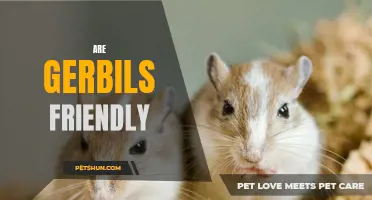
Are you looking to bring a furry friend into your life, but aren't sure where to start? Look no further than the mighty Mongolian gerbil! These adorable and social creatures make fantastic pets and are sure to bring joy and companionship to your home. Not only are they easy to care for, but they also have fascinating behaviors and unique characteristics that make them stand out from other small rodents. So, if you're ready to embark on a gerbil adventure, read on to discover why the Mongolian gerbil may just be the perfect pet for you.
| Characteristics | Values |
|---|---|
| Scientific Name | Meriones unguiculatus |
| Common Name | Mongolian gerbil |
| Size | Small |
| Lifespan | 2-4 years |
| Diet | Omnivorous |
| Housing | Glass aquarium or wire cage |
| Temperament | Social, friendly |
| Activity Level | High |
| Exercise Needs | Regular exercise required |
| Grooming Needs | Minimal |
| Vocalization | Chirping and squeaking |
| Health Issues | Prone to respiratory infections |
| Cost | Affordable |
| Availability | Widely available as pets |
What You'll Learn
- What are the best types of enclosures to keep a mongolian gerbil pet in?
- What is the average lifespan of a mongolian gerbil pet?
- How often should a mongolian gerbil pet be fed, and what should their diet consist of?
- Are mongolian gerbil pets sociable animals that enjoy companionship?
- What are some common health issues that mongolian gerbil pets may experience, and how can they be prevented or treated?

What are the best types of enclosures to keep a mongolian gerbil pet in?
When it comes to keeping a pet Mongolian gerbil, choosing the right enclosure is crucial for their well-being and overall happiness. These small rodents are known for their high energy levels and curious nature, so providing them with an environment that allows for exploration and exercise is essential. In this article, we will discuss the best types of enclosures to keep a Mongolian gerbil pet in, based on scientific recommendations and experienced gerbil owners.
- Glass tanks or aquariums: Glass tanks or aquariums are a popular choice among gerbil owners due to their visibility and ease of cleaning. A tank with a secure mesh lid is recommended to prevent escape and provide sufficient ventilation. According to a study published in the Journal of Small Animal Practice, tanks are a suitable enclosure for gerbils as they allow for burrowing and create an environment similar to their natural habitat. It is important to provide a minimum tank size of 20 gallons to promote physical activity and prevent boredom.
- Wire cages with solid floors: Another option for housing Mongolian gerbils is wire cages with solid floors. These cages provide excellent ventilation and allow for climbing and exploring. However, it is important to ensure that the wire spacing is small enough to prevent any chance of escape. Wire cages with plastic levels or platforms can be added to provide additional space and enrichment for your gerbil.
- DIY bin cages: For gerbil owners on a budget or those who prefer a more customizable option, DIY bin cages can be a great choice. A bin cage is essentially a plastic storage bin with a secure lid that has been modified to provide adequate ventilation. This option allows for creative design and offers plenty of space for your gerbil to explore and burrow. However, it is important to drill ventilation holes around the sides and top of the bin to ensure proper air circulation.
- Multi-level habitats: Mongolian gerbils are active climbers and enjoy having multiple levels to explore. Enclosures with multiple levels, such as wire cages with ramps or platforms, or DIY multi-level setups, provide plenty of space for your gerbil to play and exercise. The different levels can be equipped with tunnels, hideouts, and toys to keep your gerbil mentally stimulated and entertained.
Regardless of the type of enclosure you choose, it is important to include suitable bedding material for your gerbil to burrow and nest in. Aspen bedding, shredded paper, or a mixture of both are recommended options. Avoid using cedar or pine shavings as these can be harmful to your gerbil's respiratory system.
In conclusion, the best types of enclosures to keep a Mongolian gerbil pet in are glass tanks or aquariums, wire cages with solid floors, DIY bin cages, and multi-level habitats. Consider your gerbil's need for burrowing and climbing, as well as their natural behaviors, when selecting an enclosure. Additionally, provide ample bedding material and enrich the environment with tunnels, hideouts, and toys to ensure your gerbil's happiness and well-being.
Battle of the Pets: Gerbils vs Rats - Which is the Better Companion?
You may want to see also

What is the average lifespan of a mongolian gerbil pet?
Mongolian gerbils, also known as desert gerbils, are small rodents that are commonly kept as pets. These adorable creatures have a relatively short lifespan compared to other pets, but can bring much joy and companionship during their time with their owners.
On average, Mongolian gerbils live for about two to four years. However, it is important to note that there are several factors that can influence their lifespan. One of the most important factors is the quality of care they receive.
Proper nutrition is crucial for the health and longevity of a Mongolian gerbil. They require a balanced diet consisting of fresh fruits, vegetables, and high-quality gerbil pellets. It is important to avoid feeding them sugary or fatty foods, as these can lead to obesity and other health issues. Additionally, providing them with fresh water at all times is essential.
Another factor that can affect the lifespan of a Mongolian gerbil is the environment in which they are kept. They should be housed in a spacious cage with plenty of room for exercise and exploration. Gerbils are active creatures and need plenty of mental and physical stimulation to thrive. Providing them with toys, tunnels, and hiding spots can help keep them entertained and prevent boredom.
Gerbils are social animals and thrive in the company of their own species. It is recommended to keep at least two gerbils together, preferably of the same sex to prevent unwanted breeding. Male gerbils may become aggressive towards each other, so introducing them at a young age is important to help them establish a bond.
Regular veterinary check-ups are also important for maintaining the health of a Mongolian gerbil. They should receive vaccinations and be checked for any signs of illness or disease. Early detection and treatment can greatly extend their lifespan.
While the average lifespan of a Mongolian gerbil is two to four years, some gerbils have been known to live up to six years or more with proper care. One example of a gerbil that lived a long and healthy life is Charlie, a Mongolian gerbil owned by Mary Johnson. Charlie lived to be six years old, and his owner attributes his long lifespan to a healthy diet, a spacious and stimulating environment, and regular veterinary care.
In conclusion, the average lifespan of a Mongolian gerbil pet is two to four years. However, with proper care and attention to their diet, environment, and social needs, gerbils can live even longer. Providing them with a balanced diet, a spacious cage, companionship with their own species, and regular veterinary check-ups can greatly contribute to their overall health and longevity. By following these guidelines, owners can ensure that their furry friends live a happy and fulfilling life.
Exploring the Friendliness of Gerbils: What You Need to Know
You may want to see also

How often should a mongolian gerbil pet be fed, and what should their diet consist of?
Mongolian gerbils make adorable and low-maintenance pets. However, as with any pet, it is essential to provide them with a proper diet to promote their overall health and well-being. In this article, we will discuss how often you should feed a Mongolian gerbil and what their diet should consist of.
Mongolian gerbils are omnivorous, meaning they eat both plant and animal-based foods. In the wild, their diet primarily consists of seeds, grains, insects, and small amounts of fruits and vegetables. Therefore, it is important to replicate this natural diet as closely as possible when feeding them in captivity.
The first factor to consider when establishing a feeding schedule for your Mongolian gerbil is their age. Young gerbils should be fed twice a day, while adults can be fed once a day. The portion size should be small, enough for them to finish in one sitting, to prevent overeating.
Now let's dive into the specific components of a Mongolian gerbil's diet:
Seeds and Grains:
Seeds and grains should form the base of a gerbil's diet. You can provide them with a high-quality gerbil mix, which usually includes a combination of sunflower seeds, millet, oats, and other grains. This mix not only provides essential nutrients but also stimulates their natural foraging behavior.
Insects and Protein:
Gerbils are opportunistic eaters and do well when provided with a source of animal protein. You can offer them small amounts of insects such as mealworms or crickets a few times a week. You can find these at pet stores, or you can even breed them yourself. Ensure that the insects are gut-loaded before feeding them to your gerbil to maximize their nutritional value.
Fruits and Vegetables:
While fruits and vegetables should not make up the majority of a gerbil's diet, they can be given as occasional treats. Offer small amounts of fresh fruits and vegetables such as carrots, apples, grapes, or broccoli. These provide additional vitamins and minerals and also add variety to their diet.
Hay:
Just like rabbits and guinea pigs, gerbils also benefit from having access to fresh hay. Hay aids in digestion and helps wear down their constantly growing incisor teeth. Timothy hay is a great option for gerbils.
Water:
Make sure your gerbil always has access to clean, fresh water. You can provide the water in a bottle with a sipper tube attached to the cage. Clean the water bottle regularly to prevent the growth of bacteria.
It is worth mentioning that a well-balanced diet is crucial for your gerbil's health. Avoid giving them excessive amounts of fatty or sugary foods, as this can lead to obesity and other health issues. Additionally, always monitor their feeding habits and adjust portion sizes accordingly. If you notice unusual weight loss or gain or any other signs of illness, consult with a veterinarian.
In conclusion, Mongolian gerbils should be fed a diet that closely resembles their natural food sources. Feed them a combination of seeds, grains, insects, fruits, vegetables, and provide access to fresh hay and water. Adjust the feeding schedule based on their age and monitor their overall health. By providing them with a nutritious and varied diet, you can ensure that your gerbil lives a happy and healthy life.
Top Picks for Bedding for Gerbils
You may want to see also

Are mongolian gerbil pets sociable animals that enjoy companionship?
Mongolian gerbils, also known as desert rats or jirds, are small rodents native to Mongolia and the surrounding areas. They are popular pets due to their friendly nature and playful behavior. Many people wonder whether Mongolian gerbils are sociable animals that enjoy companionship.
In the wild, Mongolian gerbils live in large family groups called clans. They are highly social creatures and rely on each other for survival. In captivity, they can form strong bonds with their owners and other gerbils. However, it is important to note that not all gerbils are the same, and their sociability can vary from individual to individual.
Some Mongolian gerbils are more outgoing and enjoy interacting with humans and other gerbils. They may seek out attention and actively engage in play. These gerbils are often more comfortable in pairs or small groups and thrive when they have companionship. They are known to groom each other, share food, and cuddle up together for warmth and security.
On the other hand, some gerbils are more shy and prefer to have their own space. They may still enjoy interacting with their owners, but they may not be as tolerant of the presence of other gerbils. These gerbils may become stressed or aggressive if forced to share their territory with another gerbil. In such cases, it is best to keep them as solitary pets.
When introducing new gerbils to each other, it is important to do so gradually and carefully. Gerbils are territorial animals and may view a new gerbil as an intruder. It is recommended to start by placing two separate cages next to each other so that they can get used to each other's scent. After a few days, you can try introducing them in a neutral territory, such as a playpen or a clean cage.
It is also important to provide enough space and resources for each gerbil. Gerbils need their own hiding places, food bowls, and water bottles to feel secure and avoid conflicts. Regularly cleaning their living space and providing enrichment activities, such as tunnels and toys, can also help prevent boredom and aggression.
In conclusion, Mongolian gerbils are sociable animals that can enjoy companionship. However, their sociability can vary from gerbil to gerbil, and some may prefer to be kept alone. It is important to observe their behavior and provide appropriate companionship based on their individual preferences. With proper introduction and care, Mongolian gerbils can thrive and form strong bonds with both humans and other gerbils.
The Fascinating World of Mongolian Gerbil: Domesticated Rodents as Perfect Pets
You may want to see also

What are some common health issues that mongolian gerbil pets may experience, and how can they be prevented or treated?
Mongolian gerbils, also known as desert rats, are small pets that are known for their playful and active nature. However, just like any other living creature, gerbils can experience health issues from time to time. It is essential for gerbil owners to be aware of these common health issues and take preventive measures to ensure the well-being of their pets. In this article, we will discuss some of the common health problems that mongolian gerbils may experience and how they can be prevented or treated.
Respiratory Infections:
Respiratory infections are one of the most common health issues in gerbils. These infections can be caused by bacteria, viruses, or even environmental factors such as dust or poor ventilation. Symptoms of respiratory infections in gerbils may include sneezing, wheezing, difficulty breathing, and nasal discharge. To prevent respiratory infections, it is crucial to maintain a clean and dust-free environment for your gerbil. Regularly clean their cage, provide adequate ventilation, and avoid exposing them to cigarette smoke or other irritants. If your gerbil does develop a respiratory infection, it is essential to seek veterinary assistance promptly. Your vet may prescribe antibiotics or other medications to treat the infection.
Skin Issues:
Gerbils are prone to various skin problems, including mites, ringworm, and fungal infections. Symptoms of skin issues in gerbils may include hair loss, itching, redness, scabs, or lesions. To prevent skin problems, it is vital to keep your gerbil's cage clean and provide them with proper bedding and substrate. Regularly check your gerbil for any signs of skin issues and seek veterinary assistance if necessary. Treatment for skin problems may involve medicated baths, topical creams, or medication prescribed by your vet.
Dental Problems:
Gerbils have continuously growing teeth, and if their teeth become overgrown, it can lead to dental problems. Symptoms of dental issues may include difficulty eating, drooling, weight loss, and bad breath. To prevent dental problems, it is crucial to provide your gerbil with chew toys or blocks to gnaw on. These toys help wear down their teeth and prevent overgrowth. Additionally, feeding your gerbil a proper diet that includes roughage, such as hay, can also help keep their teeth in good condition. In case of dental problems, it is essential to seek veterinary assistance. Your vet may need to trim or file your gerbil's teeth to correct the issue.
Diarrhea:
Gerbils can sometimes develop diarrhea, which can be caused by various factors such as diet changes, infections, or parasites. Symptoms of diarrhea in gerbils may include loose, watery, or discolored stools. To prevent diarrhea, it is essential to provide your gerbil with a balanced diet that includes fresh fruits, vegetables, and a good quality gerbil pellet food. Avoid sudden diet changes as it can upset their digestive system. If your gerbil does develop diarrhea, it is important to seek veterinary assistance. Your vet may recommend dietary changes, medication, or other treatments to help resolve the issue.
Tumors:
Gerbils can also develop tumors, which can be benign or malignant. Tumors can occur in various parts of their body, including the mammary glands, skin, reproductive organs, or internal organs. Symptoms of tumors in gerbils may include lumps or bumps, weight loss, lethargy, or changes in behavior. Unfortunately, prevention of tumors is challenging as some may develop due to genetic factors. However, regular health check-ups by a veterinarian can help detect tumors early. If a tumor is detected, your vet may recommend surgical removal or other treatments depending on the type and location of the tumor.
In conclusion, understanding and being aware of the common health issues that mongolian gerbils may experience is crucial for gerbil owners. By taking preventive measures and seeking veterinary assistance when needed, you can ensure the overall health and well-being of your pet gerbil. Regularly clean their cage, provide them with a proper diet, and schedule routine vet check-ups to detect any health issues early. By doing so, you can enjoy a happy and healthy life with your beloved gerbil companion.
Exploring the Lifespan of Gerbils: How Long Do They Really Live?
You may want to see also
Frequently asked questions
Mongolian gerbils are small rodents that typically grow to be around 4-5 inches long, not including their tail.
Mongolian gerbils are omnivores and have a diet that consists of a variety of foods. Their primary diet should consist of a high-quality gerbil food mix, supplemented with fresh fruits and vegetables. They also enjoy occasional treats such as mealworms or sunflower seeds.
Mongolian gerbils can make great pets for children, as they are generally easy to handle and care for. However, it is important to note that gerbils are small and delicate, so children should always be supervised when handling them. It is also important to teach children about the proper care and handling of gerbils to ensure the well-being of the pet.
Mongolian gerbils are highly active and need plenty of exercise to stay healthy and happy. It is recommended to provide them with a large and spacious habitat with plenty of room for them to run, play, and burrow. Additionally, providing them with toys and tunnels can help provide mental and physical stimulation. Regular supervised playtime outside of their habitat is also beneficial for gerbils.







